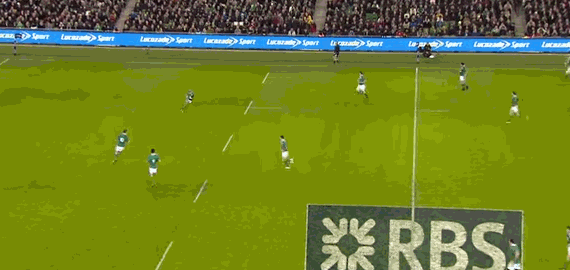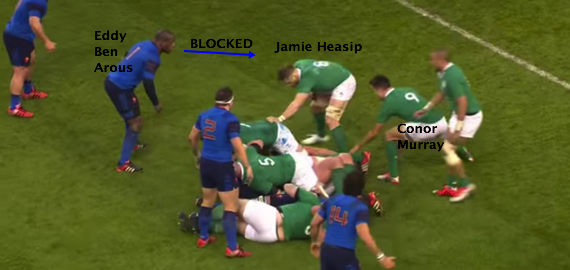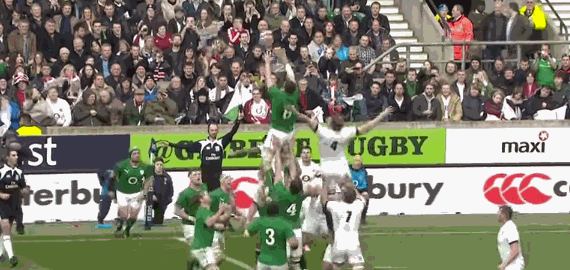England will have to deal with arguably the smartest half-back pairing on the planet in Dublin. We analyse what Ireland's nine-ten axis will offer.
“Certainly our back three are going to be tested, but whatever combination we go with will be ready. We know it is going to come our way again.” Stuart Lancaster
Kicking – grubbers, Garryowens, hacks, spirals, take your pick – is a central feature of modern day Test rugby. For all their clinical attacking and ferocious physicality, one of New Zealand’s most influential attributes is how their playmakers use their feet. It is an integral aspect of All Black success.
A consistent kicking game can relieve pressure, control territory and unpick even the most watertight of defensive walls. On Sunday, expect England’s back three to be thoroughly examined by two of the best in the business.
Alex Goode has faced the barrage before, exuding classy calm in 2013 as the visitors prevailed 12-6. Jack Nowell stood firm at Twickenham a year ago too. This will be a fresh experience for Anthony Watson, but the Bath youngster possesses star quality.
In any case, as Lancaster knows, the storm is coming. Here is a look at how Conor Murray and Jonathan Sexton – two of the very best in the business – will look to strike through the heart of England in Dublin.
Hitting corners, keeping it contestable and boxing clever
The best place to start is with this duo’s bread and butter, the tools they use in game management. First up, Sexton is a master at pinning corners, sending the ball over a wing’s head and landing it close to the touchline.
This one during the 18-11 win over France was marginally overcooked, rolling into the dead-ball area rather than into touch. Even so, the fly-half gets excellent weight on the connection allied to intelligent direction:
Of course the resultant 22 drop-out handed possession back to Ireland in any case. Camille Lopez‘s restart found its way back to Sexton rapidly, and he showed another string to his bow on the return with an archetypal up and under:
Rob Kearney, an extremely effective aerial presence, enhances the work of Sexton hugely here, haring in pursuit of this bomb and beating Scott Spedding to it.
The Leinster full-back was also a willing ally for Murray, whose was typically precise against Les Bleus:
The box-kick is normally executed methodically. Popular in recent seasons has been the practice of deploying guards in front of the kicking foot. Usually large forwards, they are loosely attached to the ruck and responsible for easing pressure from a potential charge-down.
As this screenshot depicts, Jamie Heaslip assumes the role in this case, stopping France loosehead Eddy Ben Arous getting anywhere near Murray:
Helped by that, this connection is excellent. However, as the old saying goes, the kick is only as good as its chase. Luckily then, Kearney flies upfield to make the tackle on Spedding with flawless timing.
As Peter O’Mahony and Devin Toner hit the breakdown, Damien Chouly (circled in blue) sinks, failing to support his bodyweight in a bid to seal the ruck:
A penalty is awarded by referee Wayne Barnes and Ireland have a very satisfactory return. Later though, another Murray-Kearney combination won the ball back outright:
Toner is the designated blocker and again the weight is outstanding, so much so that Kearney comes through to leap against scrum-half Rory Kockott:
While not collecting cleanly, Kearney has turned to face his own teammates. As such, the ricochet can be swooped on by Heaslip.
Chipping away
The luxury of having Robbie Henshaw, Jared Payne and Tommy Bowe in wide channels is that opposition defences must always be mindful of Ireland’s running game. That means pushing up flat to deny them space.
The consequence of that is that space is left in behind. Needless to say, Sexton is a master at exploiting any such gaps. Here a deft dink sees covering Spedding nudged into touch after Teddy Thomas presses:
A reverse angle offers a decent idea of the dilemma facing a rival team. It is suicide to ignore the possibility that Ireland will put the ball through the hands, but mightily tough to look after every blade of grass:
Sexton caught France napping once more in the second period following a restart. Though the visitors scrambled back to escape, a simple stab caused havoc:
Acute spatial and personal awareness are in play here. A bird’s eye view is easiest for us mere mortals, and allows us to see why Sexton takes this option – because replacement scrum-half Morgan Parra has strayed shallower and wider than a customary sweeping position to protect France from Ireland’s wide runners.
There is an expanse free down the middle, so Sexton calls chasers onto his inside in the form of Kearney and Sean Cronin before dropping onto his boot:
Loann Goujon saves the situation, but it provides a lesson. You can never switch off with Sexton around.
Carving out chances
As mentioned above, kicking is also a significant source of try-scoring opportunities. Indeed, Bowe’s match-clinching effort to beat South Africa was a prime example – and one in which a multi-step strategy fell into place flawlessly:
With the Springboks down to 14 men thanks to a sin-binning for hooker Adriaan Strauss, Bismarck du Plessis has replaced flanker Marcel Coetzee. South Africa are one man short in the back row, to Sexton takes them on and ties them in.
Duane Vermeulen makes the tackle and, expecting a wave of forward runners heading the same way, Schalk Burger understandably trundles around the corner:
Arriving on the scene quickly, Murray can look up to see that Bryan Habana, wary that his team might be short on numbers on the openside, has wandered infield from his post on the blindside wing. Bowe is unmarked and in the clear:
It is worth a closer look to gauge the quality of Murray’s contribution:
Finally, we rewind a year to Ireland’s trip to Twickenham and a characteristic piece of Sexton trickery:
Lancaster talks about his back three needing to read the body language of fly-halves in order to decide how to defend. This play shows how difficult that skill can be.
Sexton only goes cross-field after a double slice, first Chris Henry feeding Murray behind Gordon D’Arcy…
…and then Murray hitting Sexton behind Brian O’Driscoll:
In two passes with two decent decoy lines, Sexton is in midfield faced with a defence that is anticipating a midfield threat. With Jonny May edging off his wing, he finds Trimble with an inch perfect clip:
Ironically, given neither will face Ireland on Sunday, Mike Brown and May did brilliantly here, shooting back to avert the immediate danger. Still, this sequence is a concrete illustration of how Sexton manoeuvres defenders.
England know this tactical threat is at hand. The question is whether or not they can quell it.
























